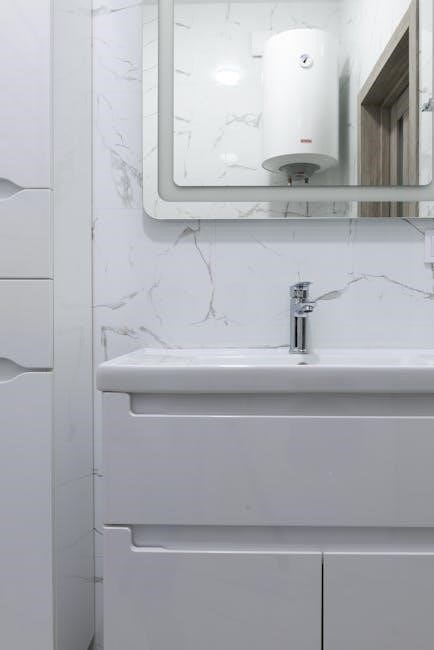Rheem tankless water heater installation requires careful planning and execution, using
- specific methods and tools to ensure proper function and safety, following manufacturer guidelines and local regulations always.
Overview of Rheem Tankless Water Heater Models
Rheem offers a range of tankless water heater models, including the Ikonic Commercial Tankless line, designed for indoor and outdoor applications, minimizing building envelope impact and allowing additional install scenarios. These models provide high-efficiency and low-emission options, making them suitable for various installation needs. The Rheem tankless water heater models are designed to provide continuous hot water supply, with features such as temperature control and flow rate adjustments. The models vary in terms of capacity, flow rate, and energy efficiency, allowing users to choose the most suitable option for their specific needs. By understanding the different models and their features, users can make informed decisions when selecting a Rheem tankless water heater for their installation. The various models are designed to cater to different user requirements, ensuring that there is a suitable option for every installation scenario. Rheem’s models are designed to be reliable and durable.

Pre-Installation Requirements
Ensure proper
- ventilation and electrical connections before starting the installation process always.
Checking Local Building Codes and Regulations
It is essential to check local building codes and regulations before installing a Rheem tankless water heater, as these can vary by location and may impact the installation process.
Using online resources or consulting with local authorities can help ensure compliance with relevant laws and regulations.
The installation must meet specific requirements, including those related to ventilation, electrical connections, and piping.
A thorough review of local building codes and regulations can help prevent potential issues and ensure a safe and successful installation.
Additionally, some areas may have specific requirements for tankless water heater installations, such as permits or inspections.
By checking local building codes and regulations, homeowners and installers can ensure that the installation is done correctly and in compliance with all relevant laws and regulations, which is crucial for safety and efficiency.
This step is crucial in the installation process and should not be overlooked.

Rheem Tankless Water Heater Installation Process
Rheem tankless water heater installation involves several steps, including preparation, installation, and testing, using specific tools and following manufacturer guidelines always carefully.
Mounting and Connecting the Unit
To mount and connect the Rheem tankless water heater unit, follow the manufacturer’s instructions carefully, using the provided mounting hardware and ensuring a secure and level installation. The unit should be mounted in a well-ventilated area, away from combustible materials and with adequate clearance for maintenance and repair. The water and gas connections should be made according to the manufacturer’s specifications, using the correct pipe fittings and sealing materials to prevent leaks and ensure a safe and efficient operation. The electrical connections should also be made carefully, following the manufacturer’s wiring diagram and using the correct electrical connectors to prevent electrical shock or fire hazards. By following these steps, you can ensure a safe and proper installation of your Rheem tankless water heater unit. The installation process requires attention to detail and adherence to safety protocols.

Configuring the Rheem Tankless Water Heater
Using the control panel and menu options to set temperature and flow rates, configuring the unit for optimal performance and efficiency always.
Setting Up the Temperature and Flow Controls
To set up the temperature and flow controls, navigate to the control panel and select the menu options, then choose the desired temperature and flow rate settings. The Rheem tankless water heater allows for precise control over temperature and flow rates, ensuring optimal performance and efficiency. Using the control panel, users can adjust the temperature in increments and set the flow rate to meet their specific needs. Additionally, the unit features advanced sensors and controls that continuously monitor and adjust the temperature and flow rate to ensure a consistent and reliable supply of hot water. By following the manufacturer’s instructions and guidelines, users can easily set up and configure the temperature and flow controls to meet their specific requirements and preferences, ensuring a safe and efficient operation of the Rheem tankless water heater. The process is straightforward and user-friendly.
Troubleshooting and Maintenance
Rheem tankless water heaters require regular maintenance and troubleshooting to ensure optimal performance and safety, using specific
- methods and tools always.
Common Issues and Repair Solutions
Rheem tankless water heaters can experience issues such as leaking, overheating, or faulty temperature control, which can be resolved with proper troubleshooting and repair methods.
Using online resources and manufacturer guidelines, users can identify and fix common problems, including issues with the heating element, thermostat, or water flow sensor.
A list of potential issues and corresponding solutions can be found in the user manual or on the manufacturer’s website, providing step-by-step instructions for repair and maintenance.
Additionally, users can contact a professional plumber or the manufacturer’s customer support for assistance with more complex issues, ensuring the water heater is functioning safely and efficiently.
Regular maintenance, such as cleaning and inspecting the unit, can also help prevent issues and extend the lifespan of the water heater.
By following proper repair and maintenance procedures, users can enjoy a reliable and efficient supply of hot water from their Rheem tankless water heater.

Additional Installation Scenarios and Applications
Rheem offers flexible installation options for various applications, including outdoor and indoor settings, using specific
- mounting methods and accessories.
Outdoor and Indoor Installation Options and Considerations
Rheem tankless water heaters can be installed in various settings, including outdoor and indoor locations, offering flexibility and convenience. The installation process for outdoor units requires careful consideration of weather conditions and protection from the elements.
Indoor installations, on the other hand, need to take into account ventilation and clearance requirements to ensure safe and proper operation. Rheem provides specific guidelines and recommendations for both outdoor and indoor installations, including mounting methods and accessories.
By following these guidelines and considering the unique characteristics of each installation location, homeowners and installers can ensure a successful and efficient installation of their Rheem tankless water heater, minimizing potential issues and maintenance needs. Proper installation is crucial to maximize the benefits of a tankless water heater.